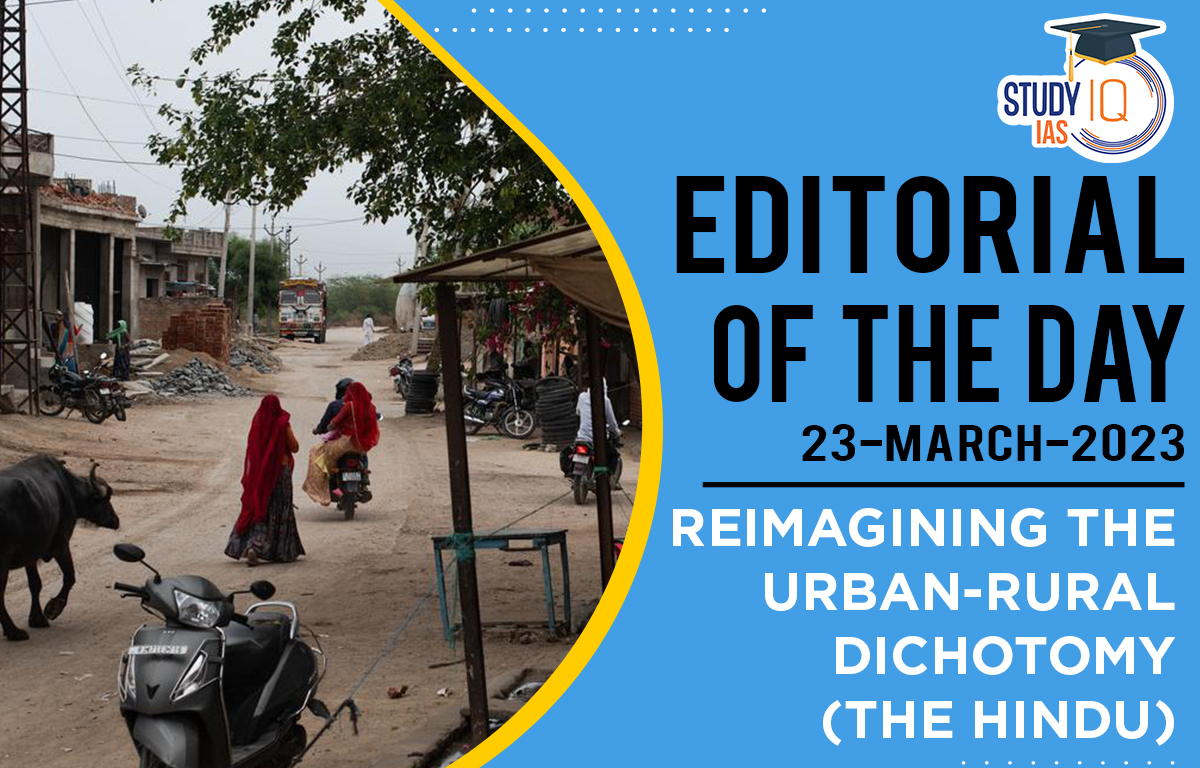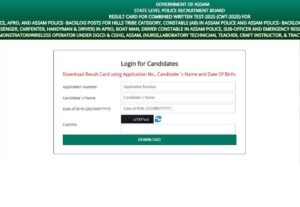Table of Contents
Context: The article highlights that the conventional approach of dividing areas into rural and urban categories (rural-urban dichotomy) is inadequate for understanding and tackling problems such as poverty, malnutrition, education, healthcare, environmental management, and overall development. It emphasizes on the intermediate settlement that exists between the rural and urban areas, where the functions overlap and where there is coexistence via shared geography, culture, economy, and history. Therefore, the article paves way for policymakers to adopt a more nuanced approach that recognizes the interactions and interdependencies between different types of settlements for promoting sustainable development.
Reimagining the Urban-Rural Dichotomy Background
Understanding Rural-Urban Dichotomy:
- Rural-urban dichotomy is the classification of areas into two distinct categories: rural and urban.
- It is based on the assumption that a clear and distinct division exists between rural and urban areas, which are seen as two distinct and separate entities in terms of social, economic, and cultural characteristics.

What is rural-Urban Continuum and how is it different from the Rural-Urban dichotomy?
| Rural-Urban Continuum | Rural-Urban Dichotomy | |
| Definition | Recognizes that the boundaries between rural and urban areas are not always clear-cut and that there are areas that share characteristics of both. | Classifies areas into two distinct categories: rural and urban. |
| Settlement Types | Recognizes the existence of an intermediate settlement formation that lies between rural and urban areas | Rural and urban areas are viewed as separate and distinct types of settlements |
| Characteristics | Settlements can exhibit characteristics of both rural and urban areas, and their characteristics can vary depending on their location along the rural-urban continuum. | Rural areas are typically characterized by low population density, agriculture-based economies, and limited access to services, while urban areas are characterized by high population density, non-agricultural economies, and better access to services |
| Policy Implications | Policies need to be tailored to specific settlement types and their location along the rural-urban continuum | Policies are typically designed separately for rural and urban areas |
Significance of Rural-Urban Continuum in Policy-Making and Governance:
The rural-urban continuum offers a more nuanced approach in addressing development challenges via effective policy making and governance:
- Targeted Policies: One of the significant benefits of the rural-urban continuum approach is that it allows policymakers to tailor their policies to specific areas and their unique needs. This can lead to more targeted policies that are better suited to the realities on the ground.
- Sustainable Development: The rural-urban continuum recognizes the interconnections between rural and urban areas and promotes a more sustainable approach to development. Policies that take into account the continuum can help to promote balanced and sustainable development, preventing the environmental degradation and social inequality that can arise from uncontrolled urbanization.
- Infrastructure Planning: The rural-urban continuum can be helpful in planning infrastructure projects. For example, a rural area that is situated close to an urban area may need different infrastructure investments compared to a more isolated rural area. The rural-urban continuum can help policymakers to understand the unique infrastructure needs of different areas along the continuum and to plan investments accordingly.
- Regional Development: Policies designed along the rural-urban continuum can help promote regional development. By recognizing the diversity of settlement patterns across a region, policymakers can develop policies that work to improve economic opportunities, social services, and infrastructure across the region as a whole.
- More Comprehensive Approach: The rural-urban continuum approach is more comprehensive than the rural-urban dichotomy. It helps to frame more effective policies that address the root causes of development challenges rather than just treating the symptoms.
Decoding the Editorial
The article discusses how effective policy formulation can be with a nuanced approach that takes into consideration the interconnectedness of the rural and urban areas that would eventually lead to sustainable development.
It analyses the 2021 World Bank Policy Research Working Paper, ‘Economic and social development along the urban-rural continuum-New opportunities to inform policy’. The Key takeaways are:
- The traditional dichotomy of rural and urban areas is inadequate to understand and address issues related to poverty, education, health, and environment.
- A continuum-based approach is needed to understand the diverse settlement patterns along the rural-urban gradient.
- Policies designed along the continuum can help promote sustainable development, regional development, and infrastructure planning.
- Adopting geographically nuanced perspectives in development can help address increasing spatial inequality and promote more effective development outcomes.
- Policies designed along the continuum can help integrate policies across different development sectors.
- Adopting a continuum-based approach can help address issues related to natural resource management by promoting sustainable land use practices and protecting ecosystems.

India’s best Example of Rural-Urban Continuum: Kerala
Kerala, a state in southern India, is often cited as an example of successful rural-urban continuum development with a thriving agricultural sector, a strong knowledge-based economy, and a high quality of life for its residents. This is because of:
- Land reform: Kerala underwent a series of land reforms in the 1950s and 1960s, which redistributed land from large landowners to small farmers. This helped create a more equitable distribution of land, which in turn led to the development of a strong agricultural sector.
- Education: Kerala has high levels of literacy and education, which has led to a skilled workforce and the development of a strong knowledge-based economy.
- Healthcare: Kerala has a strong public healthcare system, which has led to better health outcomes and a healthier workforce.
- Decentralization: Kerala has a strong tradition of local self-governance, with a decentralized system of governance that empowers local communities to make decisions about their own development.
- Social welfare: Kerala has implemented a range of social welfare programs, including a comprehensive public distribution system that provides food and other essentials to the poor.
- Infrastructure: Kerala has invested heavily in infrastructure, including roads, bridges, and ports, which has helped connect rural and urban areas and promote economic development.
Current Trends in Rural-Urban Continuum
Reasons for narrowing dichotomy:
- Globalisation:
- Over the past few decades, technology and economic globalisation have increased mobility of resources and people, and enhanced inter- and intra-country connectivity.
- The extension of transport and communication systems, improved access to energy, increased affordability private and public transport as well as penetration of economic and other networks into remote areas promote a rural-urban continuum.
- Melting of Physical Barriers: The barriers due to physical distance are melting as increasing rural-urban linkages have given rise to diffused network regions.
- Strong production-labour market linkages: Rural hinterlands are connected to multiple urban centres. The movement of goods, people, information and finance between sites of production and consumption has strengthened linkages between production and labour markets.
- Emergence of Mixed Economy Zones: As the pull factors grow, push factors driving populations out from both rural areas and urban areas are also intensifying. In the process, a mixed economy zone of primary and secondary-tertiary sectors has evolved.
The Real Challenge: Changing Ecosystem
The rural-urban continuum areas also witness changing ecosystems.
- Agriculturally productive lands are being given for other uses.
- Food security zones are being reconfigured.
- Areas for pollutant filtering are declining. There is an increase in waste dump, enhanced disaster risk, and elevated vulnerability.
- The access of local people to water, food, fuel, fodder and fibre from ecosystems is reducing.
- At the same time, intermediary market institutions are emerging to provide these goods, which have significant implications for the local people.
- There is also an escalation of market value of land, which further marginalizes them.
Systems Approach: A Possible solution
- The key challenge so far for decision-making has been the lack of rural-urban partnership. To build this, the author suggests a systems approach– where the city and the surroundings form a city region for which a perspective plan is prepared integrating rural and urban plans within a common frame. By this, the city and the rural areas will finally move towards a post-urban world where the rural-dichotomy will no longer exist.
Beyond the Editorial
India has implemented various policies and initiatives to promote rural-urban continuum and ensure effective governance and policy making.
- National Rural Employment Guarantee Scheme (NREGS): This scheme provides a legal guarantee of 100 days of wage employment in a financial year to adult members of rural households. This has helped to promote rural employment and reduce rural-urban migration.
- Pradhan Mantri Gram Sadak Yojana (PMGSY): This scheme aims to provide all-weather road connectivity to all rural habitations in India. This has helped to improve connectivity between rural and urban areas, facilitating the movement of goods and people.
- National Rural Livelihood Mission (NRLM): This mission aims to promote rural livelihoods by providing skill development, financial support, and market linkages to rural entrepreneurs. This has helped to promote rural entrepreneurship and reduce the dependence of rural areas on urban centres.
- Smart Cities Mission: This mission aims to promote the development of smart cities that are sustainable, livable, and inclusive. This includes the development of urban infrastructure and services that are accessible to both urban and rural areas.
- Digital India Mission: This mission aims to promote digital connectivity and access to digital services in rural areas. This has helped to bridge the digital divide between rural and urban areas, enabling rural areas to access the benefits of technology and e-governance.
- Swachh Bharat Abhiyan: This campaign aims to promote cleanliness and sanitation in rural and urban areas. This has helped to improve the quality of life in rural areas and reduce health hazards.


 Assam Police Constable Cut off 2025
Assam Police Constable Cut off 2025
 National Supercomputing Mission (NSM)
National Supercomputing Mission (NSM)
 Asola Bhati Wildlife Sanctuary, Location...
Asola Bhati Wildlife Sanctuary, Location...





















